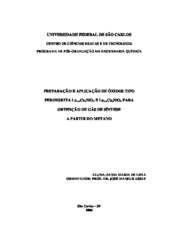Preparação e aplicação de óxidos tipo perovskita La1-xCexNiO3 e La1-xCaxNiO3 para obtenção de gás de síntese a partir do metano.
Abstract
Catalysts precursors with perovskite structure like La1-xCexNiO3 ( x = 0,
0.03, 0.05, 0.1, 0.4 ,0.7) and La1-xCaxNiO3 (x = 0, 0.05, 0.1, 0.3, 0.5, 0.8) have
been prepared by three different methods: precipitation, citrate and citrate with
successive additions. The loss of mass and structure transformations during the
calcination were studied by thermogravimetric and thermodifferential analysis;
the calcined samples were characterized by X-ray diffraction, specific surface area
measurements (BET method), temperature-programmed reduction,
thermogravimetric analysis in H2 atmosphere, temperature-programmed
desorption of oxygen, X-ray photoelectron spectroscopy and sequential pulse
experiments with CH4/O2/CH4. The catalysts were tested in CO2 reforming and
partial oxidation of methane. After the tests, the catalysts surface was studied by
scanning electron microscopy and thermogravimetric analysis in oxidant
atmosphere.
Small quantities of NiO were observed together the perovskite structure
even for x = 0 in the solids prepared by all the synthesis methods. In the Ce-La
series with x ≥ 0.05 were also identified CeO2 and La2NiO4; the perovskite
structure formation for x = 0.7 was not observed. For the samples containing Ca
with x ≥ 0.1, in addition to the perovskite structure, was observed NiO and
La2NiO4; when x ≥ 0.3 an additional CaO phase was identified. However, in these
samples, the perovskite structure was still observed even with high Ca contents.
The reaction results of CO2 reforming of methane showed that the Cecatalysts
prepared by citrate route presented Ni particles smaller and with better
dispersion than the catalysts obtained by precipitation. This was evidenced by the
higher resistance to carbon formation. Among these catalysts, the La0.95Ce0.05NiO3
was the most promising because it was the most active and resistant to carbon
formation. This carbon deposition resistance was due to the predominance of
perovskite structure that resulted in higher dispersion of nickel particles and also
to the presence of the incorporated cerium that increased its stability. The Ce
containing catalysts obtained by the two citrate methods deactivated during the
partial oxidation of methane due to the oxidation of active Ni fractions. These
oxide sites favored the CO2 formation via the combustion of methane reaction. In
the other hand, the catalysts obtained by precipitation were highly active to CO
formation, and the most promising were those with x = 0 and x = 0.05.
The Ca content influenced the carbon deposition resistance and the
conversion levels in the CO2 reforming of methane. In partial oxidation of
methane, for some contents of calcium, the reactants conversion levels have
decreased due to the oxidation of active Ni fractions, but there was no carbon
formation for all the catalysts.
